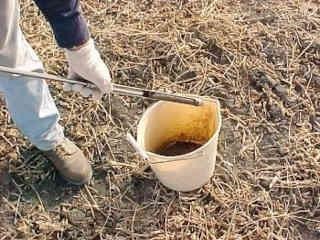By Dr. Antonio Mallarino
October began dry across most of Iowa except for some areas in southern and southeast Iowa. These conditions are allowing for rapid harvest progress. The outlook for the rest of the month calls for lower than normal rainfall. Below normal rainfall since August until the soil sampling time may result in lower than expected soil test results for phosphorus (P), potassium (K), and pH. Therefore, farmers and crop consultants should interpret those soil test results with caution.

Additionally, soil sampling with dry soils needs to be done carefully to avoid losing loose topsoil from the probe, which may result in even lower P and K values. This will especially be the case when sampling no-till fields or pastures because of the usual nutrient accumulation in the top few inches of soil. The correct 6-inch sampling depth also may be compromised with highly compacted or loose soil.
Effects on soil P and K
An article written in the Fall of 2020 discusses in detail how to interpret soil test results for P, K, pH, and buffer pH with late summer and early fall drought. The following are quick reminders:
With lower yield than expected, P and K removal with harvest will be lower than normal, and in theory would result in higher than expected soil P and K levels. However, a couple of processes may counteract this possible increase and most likely will result in lower soil-test P and K results than expected.
- Below normal rainfall from the time of physiological plant maturity until the time of soil sampling results in much less K recycling to the soil than normal, and consequently lower soil-test K levels than with normal fall rainfall.
- While a small soil-test P reduction is possible, it is also less likely.
- Scarce or no rainfall since early September slows down the normal reactions between soil nutrient pools, which often results in lower soil-test P and K levels. Plants are like pumps taking up P and K from the soil, but the uptake decreases sharply a couple of weeks before the crop reaches physiological maturity. Normal rainfall allows for the replenishment of the available nutrient pools from the less available pools.
Effects on soil and buffer pH
Soil pH values likely will be less than normal (more acidic) with drought, with differences ranging from 0.1 to 0.4 pH units being common. This is because small concentrations of soluble salts normally present in the soil solution are not leached to deeper layers by rainfall, which results in higher hydrogen ion concentration and greater acidity in the topsoil. On the other hand, drought has little effect on the soil buffer pH, which is used to estimate the lime requirement. Therefore, the main issue is to remember the pH may be lower than it would be if you wait to sample until after a rainfall to decide if liming is needed, but the amount of lime to apply will not be affected.
Effects on soil profile and cornstalk nitrate
Less rainfall than normal during late summer and early fall often results in higher nitrate concentrations in the soil profile and in higher values with the end-of-season cornstalk nitrate test. A Fall 2021 article discusses these issues in detail and provides advice about what to do. Even with higher nitrate levels than normal, a large reduction of the fall or early spring N rate for corn is not recommended because spring rainfall and soil nitrate mineralization/immobilization reactions frequently override fall conditions.
Consider current crop and fertilizer prices
The P and K fertilizer availability and supply this Fall are much better than last year, but the prices remain almost as high. Therefore, carefully consider how much money you are likely to make from this fall’s harvested crops, current fertilizer prices, and the difficult-to-guess crop prices for next Fall, when you plan fertilization for this Fall. This article, written in the Fall of 2021, provides useful advice about how to consider high P and K fertilizer prices.
In summary, considerations for Fall soil test interpretations with drought:
1. Delay soil sampling until about a week of meaningful rainfall occurs because it will result in a better sample and more reliable soil-test results. It is not possible to precisely say how much rainfall is helpful, but it should be sufficient to wet the soil throughout the sampling depth (usually six inches).
2. If you take the soil samples during dry conditions:
- Be careful with sampling depth control and that you collect the complete soil core.
- Remember soil K test results may be lower than they would be with normal conditions, but soil test P results probably will be less affected.
- Soil pH may be lower than in normal conditions, which may encourage you to apply lime when is not needed, but the amount of lime to apply based on buffer pH will not be much affected.
3. Do not reduce the planned N rate for corn because of higher-than-normal soil profile or end-of-season cornstalk nitrate values in the fall, unless you are ready to apply additional N in the spring or at sidedress time if spring weather suggest significant soil nitrate losses.
Source : iastate.edu